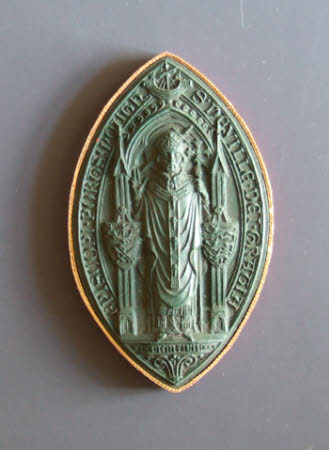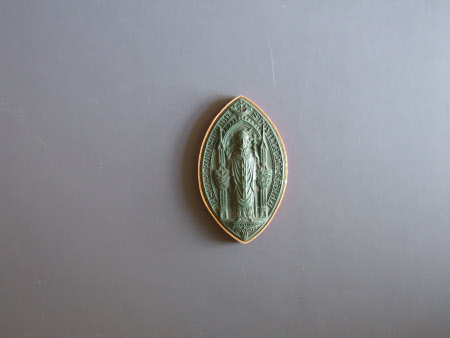Cast of the seal of Ernest Neville Lovett (1869-1951), first Anglican Bishop of Portsmouth
Category
Art / Sculpture
Date
1927
Materials
Wax
Measurements
9 x 58 x 97 mm
Order this imageCollection
Ickworth, Suffolk
NT 851658
Summary
Sculpture, wax or plaster; Impression of the seal of the first Bishop of Portsmouth, Ernest Neville Lovett (1869-1951); British, 1927. The new diocese of Portsmouth was created in 1927, the date on the seal. The first Bishop, Ernest Neville Lovett, CBE (1869-1951), was appointed Vicar and Archdeacon of Portsmouth in 1925, with the brief to establish the new diocese, which came into being in 1927, the date on the seal. Bishop Ernest, whose popularity with the Royal Navy earned him the nickname ‘the sailors’ bishop’, served his new diocese until 1936, when he was appointed Bishop of Salisbury.
Full description
An impression of a seal for the Bishop of Portsmouth, in almond (‘mandorla’) shape. In centre a standing figure of a Bishop facing to the front, in full robes and wearing a mitre, his left hand holding a crozier, right raised in blessing. He stands within a Gothic arch, at each side of him a spire to which is fastened a coat-of-arms, on the right the three lions of the royal arms, on the right the arms of the Diocese of Portsmouth, incorporating a ship (heraldic term lymphad) and keys (full heraldic description: Per fesse Or and gu1es, in chief upon waves of the sea proper a lymphad sable, and in base two keys conjoined, wards outwards, in bend, the uppermost Or, the other argent, a sword interposed between them in bend sinister argent, pommel and hilt Or). Another lymphad is at the apex of the seal. A legend runs round the edge of the seal whilst in the exergue below the Bishop’s feet is the date 1927, referring to the creation of the new diocese of Portsmouth and the enthronement of its first Bishop. The new Anglican diocese of Portmouth and the Isle of Wight was created from out of the Diocese of Winchester in 1927. Its first Bishop was Ernest Neville Lovett (1869-1951), who was appointed first Vicar of Portsmouth and then the first Archdeacon of Portsmouth, before being confirmed as its Bishop when the new diocese came into being on 1 May 1927. The new seal must have been designed between the announcement of Lovett’s appointment in May and the new Bishop’s formally taking up the role. The services for his consecration took place not in Portsmouth but in London, the service of confirmation in the church of St Mary-le-Bow in the City of London, on 13 July 1927 (The Times, 14 July 1927, p. 16) and the consecration on 25th July 1927 in Westminster Abbey. Ernest Neville Lovett, CBE (1869-1951) was ordained in 1892 and served in various parishes before his arrival at Farnham, Surrey, where he was Rector between 1908 and 1912, and where he created and produced two theatrical tableaux on the history of the town. Between 1912 and his appointment as Vicar of Portsmouth in 1925, he was Rector of St Mary’s, Southampton. Ernest Lovett served as Bishop of Portsmouth until 1936, when he was appointed to his last post as Bishop of Salisbury, from which he retired in 1946. Dr Lovett was an inspired choice as first Bishop of Portsmouth, since he had a particular affinity with the Royal Navy, coming to be known as ‘the sailors’ bishop’. He was keen to show that the Church could be experienced beyond traditional church buildings, holding services on lightships, on beaches and at harvest camps. He was also strongly opposed to the system of church patronage that at that time still operated in his diocese. It is not known how a cast of Bishop Ernest’s seal should have found its way to the Hervey family and to Ickworth. The original seal matrix (the steel seal die with the image and legends engraved in reverse, from which impressions can be made) is not known to survive, but it is likely that Bishop Ernest was allowed to take it with him when he moved to Salisbury. At the present time, the Ickworth cast appears to be the only record of this interesting item of twentieth-century church history. The consciously archaic mandorla shape and design of the style of the seal, resembling medieval and renaissance ecclesiastical seals, may have been the personal choice of Bishop Ernest. Jeremy Warren July 2025
Provenance
Part of the Bristol Collection. Acquired by the National Trust in 1956 under the auspices of the National Land Fund, later the National Heritage Memorial Fund.
Marks and inscriptions
Legend around edge: : S. NEVILLE. DEI. GRATIAE. / EPISCOPI. PORTSMOUTH Date in exergue:: MCMXXVII [1927]

